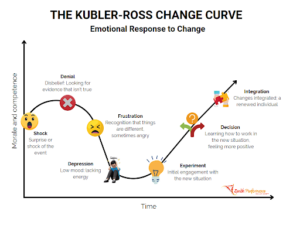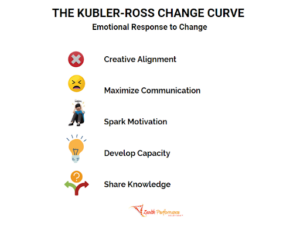Effective change management requires a deep understanding of both the emotional journey employees undergo, and the strategic actions leaders must take. In today’s blog, I want to share insights from the Change Curve model and the steps you can take as a leader to help yourself and your team navigate changes in your organization. I will also share my recent experience moving through the Change Curve myself.
My Recent Experience Navigating the Change Curve
A little backstory… Eleven years ago, I collaborated with three other leaders to create a leadership program aimed at enhancing the leadership capabilities within real estate brokerages. Our goal was to prepare future leaders through a 46-week, blended learning program focusing on personal leadership, managing others, and organizational leadership. Initially intended to last 2-3 years, the program is now graduating its 10th cohort.
This program has not only been a pivotal part of my career due to its success and longevity, but also through the incredible relationships I’ve built with talented leaders across various real estate brands. Working with an extraordinary team and witnessing the creation of a strong, interconnected network of professionals has been the most rewarding experience of my career.
Last fall, the organization asked us to reimagine what a 2.0 version of the program might look like. Over the past year, they decided to sunset the existing program and develop something new. I realized that the delivery would likely shift to internal resources, meaning the team I hold dear would eventually disband and move on to new opportunities. By December, it became clear to me that I was personally navigating through the stages of the Change Curve as these changes unfolded. Seriously, I was feeling all the feels. And as we head to New Jersey to graduate our last cohort, I am preparing myself for an emotional week.
So, what is the Change Curve? The Change Curve model illustrates the emotional stages individuals experience during change. Additionally, if you lead a team going through a big change, it can help you help your team move through these stages more effectively.
Understanding the Emotional Journey: The Change Curve
Here are the stages of the Change Curve, and some strategies you can use to help those you lead. Above you will see the initial reaction, but then you will also see these icons that indicate what you can do:


Stage 1: Shock
- Initial Reaction: “I can’t believe it.”
Stage 2: Denial
- Initial Reaction: “It will never happen.”
During the stages of Shock and Denial, one thing you can do as a leader is find alignment, you’re your team. Additionally, maximize communication. Explain the ‘why’ behind the change. Allow your team to express their feelings about the change. Consistent and constant communication is key.
Stage 3: Frustration/Anger
- Initial Reaction: “It’s not fair!”
Stage 4: Depression
- Initial Reaction: “What’s the point?”
In the stages of Frustration and Depression, as a leader, you can validate the feelings of those on your team and yourself. I say, “feel all the feels.” Allow space for expression without judgement. Engage in dialogue and help individuals see the benefits of change. Provide support and empathetic leadership. Encourage small, manageable tasks to help overcome challenges and try to spark motivation.
Stage 6: Experiment
- Initial Reaction: “I can’t fight it — I may as well prepare for it.”
During Experiment, this is the point when we stop looking behind at what was and start looking forward to what could be. As a leader, you can equip your team with the knowledge and tools they need for the change.
Stage 7: Decision:
- Initial Reaction: “I am starting to learn how to do this and am moving in a positive direction.”
Stage 8: Integration
- Initial Reaction: “How can I play a part in the future.”
Finally, the two stages, Decision and Integration, the leader is sharing knowledge, coaching their team members, getting continuous feedforward on the change, and encouraging new ideas, innovation, and continuous improvement on their teams.
Important Considerations when it Comes to the Change Curve
What is important to remember about the Change Curve is that each of us progresses through these stages at a different pace. The continuum of time across the bottom is important to recognize, and sometimes people can get stuck in one stage. As a leader, we can help our teams move to the next stage. Additionally, the continuum going up the graph is morale, energy, and performance. Note at each stage where you will observe highs and lows in these areas.
I can’t stress enough…THIS IS NORMAL!!! Let yourself and your teams feel the feels, but then help yourself and your teams move to the next stage.
Leading through change is not just about following a plan; it’s about guiding your team through an emotional journey. By understanding the stages of the Change Curve and strategically implementing change management actions, you can effectively lead your organization through transitions, turning challenges into opportunities for growth.
This isn’t the first time I have written about Change Management, here is another blog:

